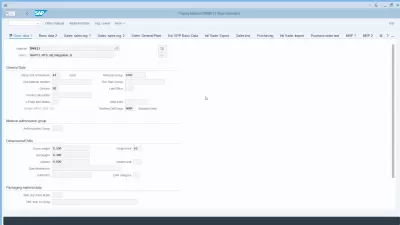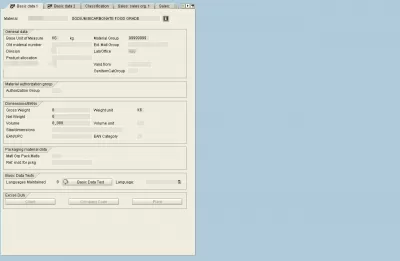SAP Material Master Basic Data 1: Simplifying Material Management with General Data
The SAP Material Master screen Basic Data 1 is a part of the SAP ERP system used to manage general data for materials within an organization. This screen allows users to view and edit information related to the basic characteristics of a material.
The Basic Data 1 screen is divided into several sections, each containing different fields for inputting and displaying information. The first section is the Material General Data section, which displays basic information about the material, such as the material number, material type, and description.
The next section is the Material Description section, which contains fields for inputting data related to the description of the material, such as the long text, short text, and international article number (EAN).
The next section is the Material Type-dependent Data section, which displays data that is specific to the material type. This section includes fields for inputting data related to the material group, weight, volume, and dimensions.
The next section is the Sales: General/Plant Data section, which displays data related to sales and distribution of the material. This section includes fields for inputting data related to the sales organization, distribution channel, and plant.
Finally, the last section is the Plant Data/Storage section, which contains fields for inputting data related to the storage and location of the material. This section includes fields for inputting data related to the storage location, storage unit, and special stock.
Overall, the SAP Material Master screen Basic Data 1 is an essential tool for managing general data for materials within an organization, providing a comprehensive view of all basic characteristics of a material in one place.
Technical details associated with BasicData1 view
The SAP Material Master screen Basic Data 1 is associated with various technical details that are essential for its proper functioning. These details include organizational units, tables, customization transactions, and business transactions.
Organizational Units:
The main organizational units associated with the SAP Material Master screen Basic Data 1 are the company code and the plant. The company code is responsible for financial accounting transactions, while the plant is responsible for the production and inventory management of the material.
Tables:
Several tables are involved in maintaining data related to the SAP Material Master screen Basic Data 1. Some of the critical tables are:
- MARA: Material Master General Data
- MBEW: Material Valuation Data
- MARD: Storage Location Data for Material
- MSEG: Material Document Data
- MLGN: Material Data for Each Warehouse Number
Customization Transactions:
The main customization transactions associated with the SAP Material Master screen Basic Data 1 are:
- MM01: Create Material Master
- MM02: Modify Material Master
- MM03: Display Material Master
These transactions are used to customize the SAP Material Master screen Basic Data 1 to meet specific organizational requirements.
Business Transactions:
The main business transactions associated with the SAP Material Master screen Basic Data 1 are:
- Purchasing: Purchase Order (PO), Goods Receipt (GR), Invoice Verification (IV)
- Sales: Sales Order (SO), Delivery, and Billing
- Production: Material Requirements Planning (MRP), Production Order, Goods Issue
These transactions are used to perform various business processes related to the procurement, production, and sale of materials within an organization.
Conclusion
In conclusion, the SAP Material Master screen Basic Data 1 is associated with various technical details that are crucial for its proper functioning. Understanding these technical details is essential for effectively managing general data for materials within an organization.
Frequently Asked Questions
- How does the SAP Material Master Basic Data 1 screen simplify material management?
- SAP Material Master Basic Data 1 screen simplifies material management by providing a centralized platform for managing general material data. This includes material descriptions, unit of measure, and material group, which are essential for efficient material tracking and inventory control.

Yoann Bierling is a Web Publishing & Digital Consulting professional, making a global impact through expertise and innovation in technologies. Passionate about empowering individuals and organizations to thrive in the digital age, he is driven to deliver exceptional results and drive growth through educational content creation.

